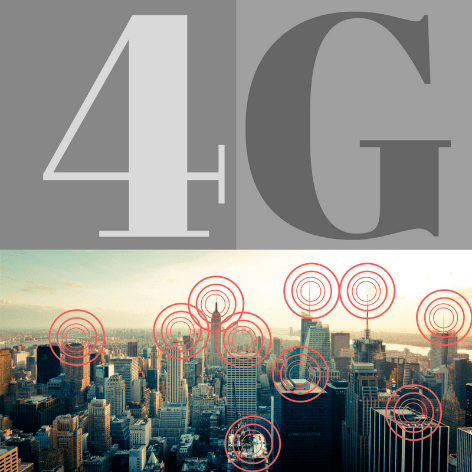The Path to 4G Network Requirements
Whether you are deeply embedded in projects related to the telecomm industry or are simply a smartphone owner, the term “4G” is probably familiar. The air interface, core network, and transport standard specifications for 4G may not be familiar to everyone.
The International Telecommunication Union (ITU) created a subsection of its organization dedicated to the Radio-communication Sector (ITU-R) in 1992. The ITU-R facilitated the eventual formation of the International Mobile Telecommunications-Advanced (IMT-Advanced Standard) by utilizing the precise expertise required to outline such detailed standards. The IMT-Advanced Standard is the name of the set of global standards created in 2008 to regulate 4G, and other generations’, network requirements for all global mobile telecommunications experts to follow.
By 2010, the ITU-R had approved two industry-developed technologies to guide 4G standards. The Long-term-evolution Advanced (LTE Advanced) specifications were submitted by 3GPP and the WiMAX release 2 specifications were submitted by IEEE. LTE Advanced has become the superior technology and is now a clear preference for engineers measuring results. This process of standardization has led to a separation of theoretical and practical requirements that can even confuse some experts.
The currently deployed 4G networks are subject to the IMT-Advanced Standard. This includes speed requirements of 1Gbps when stationary and 100Mbps when mobile. In comparison, 3G standards only required stationary speeds of 2Mbps and mobile speeds of 384kbps. Most marketers fail to explain how these requirements are actually met in practical terms. In reality, technologies began to label themselves as “4G” without actually meeting the requirements. This means that even with the addition of efficient multiplexing schemes that were added with “4G” technology, the IMT-Advanced Standard was still unmet. Recent network capability improvements have resulted in significant speed improvements, but marketers have moved ahead of engineers in making claims that 4G standards have been met.
There have been a number of additional 4G releases as capabilities approach 4G standards. Most network products in use today are utilizing “4.6G.” This term is associated with the set of standards resulting from release 11 of LTE Advanced in 3GPP. There have been 2 other sets of standards released that have yet to be utilized by real-world consumers; release 13 and release 14. It is important to Note that 5G standards are not expected until release 15 sometime near the end of 2018. SpeedGuide.net displays a simplified table of all previous network generation requirements.
What to Expect from the 5G Network Upgrade
Based on the expected releases of additional 3GPP standards, it is premature to jump ahead to the 5G standards. There is generally a delay in the deployment of products utilizing a specific standard. During this four-year period, engineers take the theoretical design and complete experimentation, field trials, testing and validation.
An HIS study on the Economic Impact of the 5G Economy indicates that current efforts for commercial deployment of 5G may begin to contribute to the global economy by 2020. However, the same study focuses, more appropriately, on a 2020 to 2035 time period. This is more suitable because they believe this period will include the bulk of realistic 5G network solutions. Articles describing “5G” as ‘just around the corner’ are quite simply well-marketed 4G improvements and are not accurate descriptions of the network in technical terms.
The study continues with several other key findings. First, in 2035, HIS expects 5G to have enabled $12.3 trillion of global economic output. This coincides with an expected 22 million global jobs created to support the new network. 2020 is no longer a realistic timeframe that marketers should be pushing onto consumers for practical 5G implementation. In fact, we will not begin to see large-scale adoption of 5G until sometime close to 2030.
Bonnie Cha from Recode takes a deeper look at the expected 5G standard release and says the expectation will be the following; “100 Billion links, 10 Gbps throughput, and 1ms latency.” The expected improvement from the current state of network capabilities is enormous. One important aspect to consider, which is frequently overlooked when discussing a 5G timeline, is the need for a complete overhaul of the current network infrastructure.
The Current State of Mobile Network Infrastructure
A 2015 Global Telecommunications Study conducted by EY points out that the Internet of Things (IoT) will drive mobile-to-mobile (M2M) connections to 1 billion by 2020. This will represent 10% of all mobile connections. The 4G infrastructure is now beginning to mature and technologies will remain focused on these networks for a long period of time. IoT applications will continue to spurn technology growth and will remain as the primary revenue driver for 4G networks until then.
Close attention to the scheduled 3GPP releases shows that current implementation and deployment of 4G LTE technology is not yet taking full advantage of the technology’s capabilities. IoT will be a major factor driving these 4G improvements because they will require a fully utilized 4G network. 5G is a long term goal for network abilities, not a current requirement for the full utilization and deployment of IoT.
Available 4G ROI versus Potential 5G ROI
Global 5G network implementation requires the market support and payment for all infrastructure needs prior to monetizing it through revenue. Customers will not be willing to pay for a service that does not yet exist. Hence, only telecom firms that have deep pockets and understand the current potential for ROI on the 4G networks are the ones who will survive to make 5G a reality.
The infrastructure required to build a 5G network will be huge. 5G World News says it will cost $104 billion to upgrade a global network. The internet needs to be rebuilt from scratch in order to allow the new infrastructure to take the load. Where do most people think this funding will come from? In some cases, governments take on a portion of this cost. We also expect industry leaders to take on (at least a portion of) these costs themselves. The industry leaders will be required to continue to create short-term revenue in order to pay for those long-term 5G infrastructure costs. For this reason, 4G will remain the leading network for much longer than many recent articles and corporate press releases have been willing to admit.
GHB Intellect has identified enough opportunity for 4G revenue over the next decade to forecast significant monetization of upcoming 4G network capabilities. We believe it is an exciting time in the telecom industry and are optimistic about 5G network potential. However, it is apparent that any “5G release” in the next couple of years will not instantly replace our 4G network growth expectations. This will not change until all 4G network capabilities have been thoroughly exhausted and 5G network infrastructure investment begins.
We frequently offer our clients technology and science assessments to improve their intellectual property merger and acquisition strategies that include highly complex research, analyses and evaluations. We use a holistic approach to answer broad requests like “What is your assessment on the approaching 5G revolution?” Our focus on very narrow technology-based details as well as the “big picture” of the relationship between a project and the industry involved is evident in our work as well.


